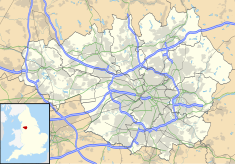Withington Town Hall
| Withington Town Hall | |
|---|---|
 The building in 2018 | |
| Location | Lapwing Lane, Withington |
| Coordinates | 53°25′33″N 2°14′16″W / 53.4259°N 2.2379°W |
| Built | 1881 |
| Architect | Lawrence Booth |
| Architectural style(s) | Baroque Revival style |
Listed Building – Grade II | |
| Official name | Former Withington Town Hall |
| Designated | 5 November 1990 |
| Reference no. | 1291512 |
Withington Town Hall, also known as West Didsbury Town Hall, is a former municipal building on Lapwing Lane, Withington, a town in Greater Manchester in England. The building, which served as the offices and meeting place of Withington Urban District Council and now accommodates a firm of solicitors, is a Grade II listed building.[1]
History
[edit]Following significant population growth, largely associated with the textile industry, a local board of health was established in Withington in 1876.[2] The new board decided to commission a venue for their meetings: the site they selected, on the south side of Lapwing Lane, was occupied by Lapwing Farm.[3] The new building was designed by Lawrence Booth in the Baroque Revival style, built in buff brick with stone dressings at a cost of £2,000 and was completed in 1881.[4] In 1882, stables and various outbuildings were added, to designs by Joseph Swarbrick.[5][6]
In 1894, the board was succeeded by an urban district council, which made the building its town hall.[7] The building ceased to be the local seat of government in 1904, when the district was annexed by the City of Manchester.[8]
The building was used as a rest centre with capacity for 300 people during the Manchester Blitz in the Second World War.[9] After the war the building remained a venue for public meetings and for dances and concerts.[10]
Manchester City Council continued to use it to deliver services until 1990, when it was declared surplus to requirements, sold for commercial use and converted into offices.[11][12] After being extensively refurbished for an events management business, APS, in 2007,[13] it went on to become the home of a firm of solicitors, Pabla and Pabla, in 2014.[14][15]
Architecture
[edit]The building is constructed of buff brick, with red brick and terracotta dressings, and a slate roof. It has a rectangular plan, with two storeys and five bays, forming a symmetrical composition. Ornamentation includes fluted pilasters, and the first floor has large windows with elliptical heads. The central bay features a round headed doorway, with voussoirs and a keystone, flanked by brackets supporting a pediment. A carved crest of the Mosley family, who were the lords of the manor, can be seen in the pediment above the doorway. The central bay also features a gable with a terracotta roundel, under a band with the wording "LOCAL BOARD OFFICES". Above this is a pyramidal turret with a clock, topped by a weather vane. Inside, there is a large staircase with an open well, and a former assembly hall on the first floor.[1]
See also
[edit]References
[edit]- ^ a b Historic England. "Former Withington Town Hall (1291512)". National Heritage List for England. Retrieved 7 March 2024.
- ^ "Introduction". Withington Civic Society. Retrieved 7 March 2024.
- ^ "Ordnance Survey Map". 1860. Retrieved 7 March 2024.
- ^ Hartwell, Clare; Hyde, Matthew; Pevsner, Nikolaus (2004). Lancashire: Manchester and the South-East. The Buildings of England. New Haven and London: Yale University Press. p. 485. ISBN 978-0300105834.
- ^ Kelsall, Frank (2006). "John Swarbrick, architect and antiquary". Transactions of the Lancashire and Cheshire Antiquarian Society. 102: 179.
- ^ "Withington Local Board Offices. Lapwing Lane, West Didsbury". Architects of Greater Manchester 1800–1940. Retrieved 6 March 2024.
- ^ Posts vacant. Vol. 31. The British Journal of Nursing with which is Incorporated the Nursing Record. 26 December 1903. p. 529.
- ^ "Township of Withington records". The National Archives. Retrieved 6 March 2024.
- ^ Phythian, Graham (2015). Blitz Britain: Manchester and Salford. History Press. ISBN 978-0750965583.
- ^ "A Walk on the West Side" (PDF). West Didsbury. p. 7. Retrieved 6 March 2024.
- ^ Fry, Kath; Cropper, Karen. "Leisure Services". Manchester 1984. Retrieved 6 March 2024.
- ^ Tague, Neil (26 October 2021). "Green light for Lapwing Lane office". Place North West. Retrieved 6 March 2024.
- ^ "Chris is copped by the high life". Manchester Evening News. 15 February 2007. Retrieved 6 March 2024.
- ^ "APS moves to Abney Hall". Place Northwest. 8 July 2014. Retrieved 6 March 2024.
- ^ "Press releases". Pabla and Pabla. Retrieved 6 March 2024.

